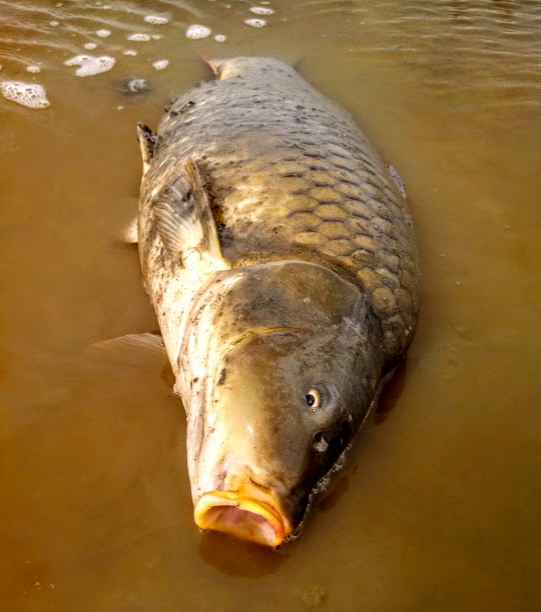By Chris Hunt
The desert of southern Idaho is immense. Sliced ear to ear by the Snake River, this place is defined by fire.
Some of the lava flows in Craters of the Moon National Monument are only 2,000 years old. Others are leftover from the last big blast from t
he Yellowstone “hot spot” that has moved over eons across the West to where it now resides and pumps geysers and hot springs from the earth every single day.
But to the west, where the river takes a lot of Yellowstone’s hot water and pumps it to the Columbia, some of the best mixed-species fishing exists, and for fly fishers, it’s a lightly pressured paradise.
Sporting trout, smallmouth bass and massive carp, the Snake features deep dives through basalt canyons, slow, froggy sections in backed up reservoirs like American Falls and Walcott and hidden backwater bays that sport flats where bass and carp come to play in the spring.
And that’s where you’ll find me on sunny, warm spring days, which, honestly, can be hard to come by in this high-elevation desert. Having lived here now for nearly 20 years, I’ve seen it snow in June and spit honest-to-God ice pellets on July 4. To see a few days in a row where the thermometer pops 70 in April or May is a Godsend, and these days are not to be wasted.
The bass are nesting along the basalt rocks of the river’s edge, and they’ll attack anything that comes close. Steamers pulled deep on sink-tip lines can bring real trophies to hand. The trout hang mostly in the first few miles below dams, where cold, bottom-release flows keep temperatures steady as the weather warms, and they, too, can be real pigs.
And, while I love trout and I’m fond of smallies, my favorite fly-rod target in the Snake is the unholy carp, a noxious invader that certainly does more harm than good. This Asian native has found a way exist in this harsh environment that barely resembles the waters in which its indigenous. But it’s here to stay—culling their numbers might be an option, but it would be pricey and likely fruitless (keep in mind that smallmouth bass are non-native, too). Instead, like the fish itself, Idaho’s anglers are adapting. While few chase carp for their flesh, Isaac Walton’s “Queen of Rivers” is increasingly being pursued for sport.
This time of year, carp are plenty sporty.
As shallows warm under springtime sun, carp begin their annual spring spawning migration. They move from the river’s depth, where they’ve spent the winter in a state of near dormancy, to the warmer shallows. The smaller males move in first, feeding voraciously on flats-living critters like damselfly nymphs and crawfish. With most in the 5- to 10-pound range, they provide the first legitimate shot of the season at burley hard-fighting fish for anglers on the river. Depending on the weather, these enthusiastic fish can be seen breaching and frolicking (presumably to attract the bigger females) as early as mid-April, but in earnest by May.
By mid-May, the big females—some pushing 30 pounds or more—are in the shallows, also feeding, but mostly preparing to spawn. By this time, the males have slowed down the bite, and instead are focused on getting females to spill eggs so they can be fertilized. Carp don’t pair up like trout or salmon. Instead females “broadcast” eggs all over the flats where multiple males can fertilize them. It is, at its most base form, a carp orgy.
Once the spawning is done and out of the way, both the males and females turn their minds to food again, the fish again become a great target for fly rodders who can find them in shallow water and target them with flies tied to imitate crawfish, small baitfish, insect nymphs and mud-dwelling worms. On the Snake, this usually happens sometime in late May or into June, when most of our fly-fishing brethren have turned their attention to trout in the higher reaches of the drainage.
It’s the best time of the year to dependably chase carp, which can often be found tailing, like bonefish or redfish, or cruising the flats and on the feed.
It’s also a time when the desert really comes to life. Not only are the carp and bass in full-on feeding mode, but rattlesnakes and bull snakes navigate the sage, and waterfowl ranging from ibis to mergansers, and herons to pelicans arrive in the river’s shallows. It’s a great time to be on the river, whether you’re fishing or not.
The carp are likely here to stay, and many anglers have grown to appreciate the sport they offer. And, after a fashion, they can honestly be described as an appealing fish. Both common carp and mirror carp are found in the Snake, and they mingle readily. Big and bronze, even their barbels come to resemble whiskers rather than uber-sensitive food-finders. After nearly two decades of chasing them, I’ve become appreciative, if not fond, of carp in the Snake. Like the desert and the river canyon itself, it’s as if they, too, were forged by fire.
And, this time of year, if I had my choice of fish to chase, I’d be hard pressed to choose any fish other than carp. They require stealth, a saltwater stalking approach and tackle that can handle their long, head-shaking runs—yes, you better check your backing knot.
So, while others are bemoaning a surging spring runoff and the damper it puts on our trout fishing, you’ll find me on the desert, sitting before a small fire under stars so bright they can’t possibly be real. I’ll listen to the coyote’s song and, hopefully, for the tell-tale splashes that promise fish on the flats come morning.
Chris Hunt is the national digital director for TROUT Media. He lives and works in Idaho Falls.



